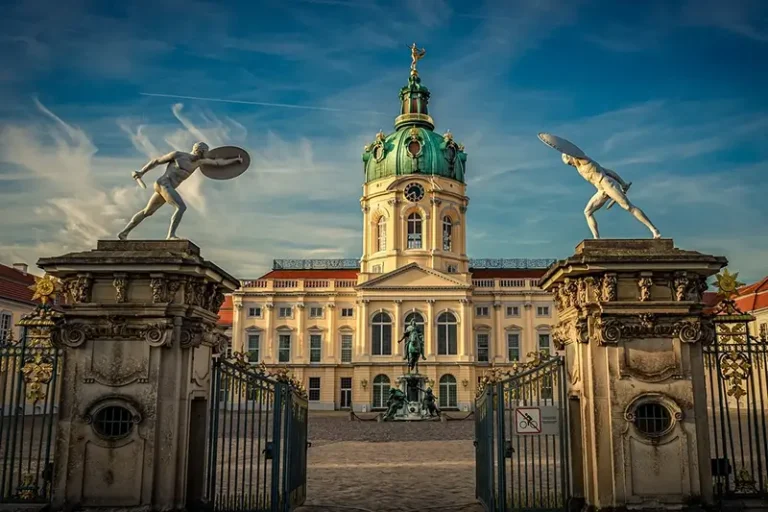Berlin, the lively capital of Germany, is a city that has something for everyone. From its world-famous landmarks to its quirky hidden corners, it is a destination where history meets modern creativity. The best tourist attractions in Berlin offer a mix of cultural, historical, and fun experiences, making it a must-visit city for travellers of all kinds.
Berlin’s history is woven into its streets, buildings, and landmarks. Whether you are exploring the remains of the Berlin Wall or visiting the grand Reichstag, the city’s past is always present. Beyond its historical significance, Berlin is a hub for arts, music, and innovative ideas, creating a vibrant energy you will feel everywhere.
For those who love art and culture, Berlin is a treasure trove. Museum Island is home to world-class museums, while the city’s street art scene is equally captivating. Each neighbourhood has its own character, offering unique places to explore.
Foodies and nightlife lovers will also find plenty to enjoy in Berlin. From cosy cafes to lively markets and vibrant clubs, the city’s culinary and entertainment options are as diverse as its attractions. There is always something happening, no matter the time of day.
Whether it is your first visit or you are returning to see more, Berlin promises experiences that will leave lasting memories. With so much to see and do, exploring the best tourist attractions in Berlin is the perfect way to immerse yourself in this extraordinary city.
The 22 Best Tourist Attractions in Berlin
Berlin Weather, When to Go & Where to Stay
Berlin Weather Overview
Berlin experiences four distinct seasons, each bringing its own charm to the city. Summers, from June to August, are warm and lively, with temperatures averaging between 20°C and 25°C. It is the perfect time to enjoy outdoor activities, parks, and festivals. Spring and autumn offer milder weather, with temperatures ranging from 10°C to 18°C. During these seasons, the city comes alive with blooming flowers in spring and colourful leaves in autumn, making it a picturesque time to visit.
Winters in Berlin, from December to February, can be cold, with temperatures often dropping below freezing. Snowfall is not uncommon, adding a magical touch to the city’s Christmas markets and festive decorations. However, the shorter days and chilly weather may mean spending more time exploring Berlin’s many museums, galleries, and cosy cafes. Whatever the season, it is always worth checking the forecast before packing for your trip.
Best Time to Visit Berlin
The best time to visit Berlin depends on your preferences and what you want to experience. Summer is ideal if you enjoy outdoor events, longer days, and exploring the city’s parks and open-air attractions. It is also the busiest tourist season, so expect larger crowds and higher accommodation prices.
Spring and autumn are great for those looking for a quieter visit with comfortable weather. These seasons are perfect for exploring the city on foot or by bike, and you will find fewer crowds at popular sites. Autumn, in particular, is a lovely time to visit, as the city’s parks and tree-lined streets turn vibrant shades of yellow and orange.
Winter is best for those who love festive atmospheres and cosy indoor experiences. The Christmas markets, ice skating rinks, and warm mulled wine make Berlin a magical destination during the holiday season. Just remember to pack warm clothes if you plan to visit in the colder months.
No matter when you choose to visit, Berlin offers something special all year round.
Best Neighbours to Stay in Berlin
Berlin is a city of contrasts, where history meets modernity and each neighbourhood has its own unique charm. Choosing the right area to stay in can make a big difference to your experience. Whether you want to be in the heart of the action, enjoy a laid-back atmosphere, or immerse yourself in arts and culture, Berlin has a neighbourhood to suit every traveller.
From vibrant nightlife to quiet, family-friendly areas, each part of the city offers something special. Here is a list of the best neighbourhoods to stay in Berlin, each with its own appeal and personality.
- Mitte: The central hub of Berlin, packed with historic landmarks, museums, and plenty of shopping and dining options. Ideal for first-time visitors.
- Kreuzberg: Known for its creative energy, this area is full of street art, unique cafes, and lively nightlife. It has a bohemian feel that draws artists and free spirits.
- Prenzlauer Berg: A charming neighbourhood with tree-lined streets, trendy boutiques, and family-friendly parks. Perfect for a more relaxed stay.
- Friedrichshain: Famous for its vibrant nightlife and the iconic East Side Gallery. A great choice for young travellers and those who enjoy a buzzing atmosphere.
- Charlottenburg: Known for its elegance and calm vibe, this area features high-end shopping, classic architecture, and the stunning Charlottenburg Palace.
- Neukölln: A diverse and up-and-coming neighbourhood, offering a mix of international cuisine, creative spaces, and a growing arts scene.
- Schöneberg: A welcoming and lively area with a mix of LGBTQ+ friendly venues, cosy cafes, and a rich history.
- Tiergarten: Close to Berlin’s central park, this neighbourhood is great for nature lovers and those seeking a quiet retreat close to the city centre.
Each of these neighbourhoods has its own distinct character, so no matter where you choose to stay, you will find something that makes your Berlin visit memorable.
Must-See Tourist Attractions in Berlin
1. Brandenburg Gate
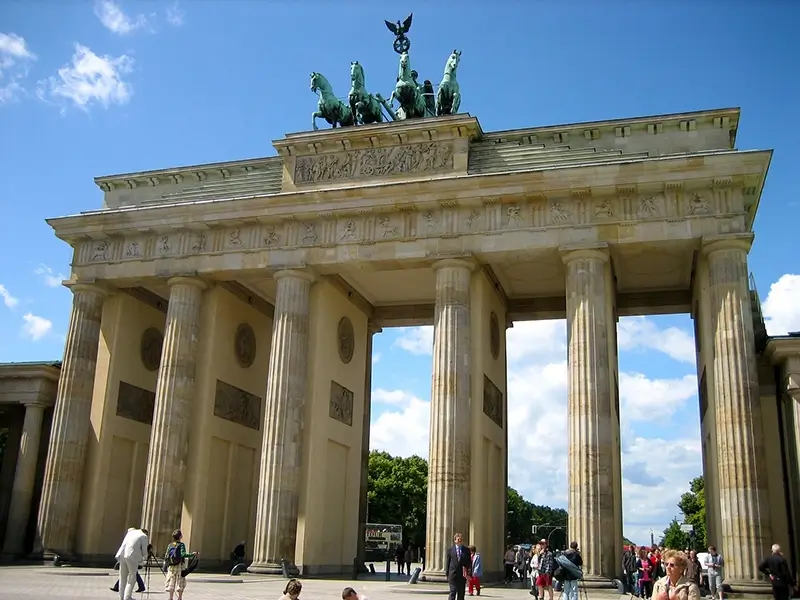
The Brandenburg Gate is one of Berlin’s most iconic landmarks and a symbol of unity and peace. Located at Pariser Platz in the heart of the city, it is close to other famous sites such as the Reichstag and the Holocaust Memorial. As a central meeting point for locals and visitors alike, it is an essential stop on any trip to Berlin.
Built in the late 18th century, the gate was commissioned by King Frederick William II of Prussia. Its design was inspired by the Propylaea, the entrance to the Acropolis in Athens, showcasing the influence of classical architecture. Over the years, the Brandenburg Gate has witnessed some of Berlin’s most significant historical events, from Napoleon’s victory parade to the fall of the Berlin Wall in 1989.
During the Cold War, the gate stood between East and West Berlin, becoming a symbol of division. When the Berlin Wall came down, it transformed into a powerful representation of reunification and hope. Today, it stands as a reminder of Germany’s complex history and its journey towards peace.
Visitors to the Brandenburg Gate can marvel at its grand structure and the Quadriga, a chariot statue at the top. The area around it is lively, with plenty of cafes and cultural activities. Whether you visit during the day or at night when it is beautifully lit, the Brandenburg Gate is a must-see for its historical significance and timeless beauty.
2. Reichstag Building

The Reichstag Building is one of Berlin’s most significant landmarks and an important symbol of Germany’s political and historical journey. Located near the Brandenburg Gate in the city’s government district, it is home to the German Bundestag or parliament. Its prominent location and striking architecture make it a standout sight for visitors.
Originally completed in 1894, the Reichstag was designed by architect Paul Wallot to house the parliament of the German Empire. Over the years, it has witnessed major historical events, including the fire in 1933 that marked the beginning of Nazi control. After being heavily damaged during World War II, the building remained in disrepair for decades, reflecting the division of Germany during the Cold War.
Following reunification, the Reichstag underwent a major renovation led by British architect Sir Norman Foster. The most striking feature added was the glass dome, which symbolises transparency in government. Visitors can walk up the spiral ramps inside the dome to enjoy incredible views of Berlin’s skyline while learning about the Bundestag through interactive displays.
The Reichstag is more than just a political building; it is a testament to Germany’s resilience and commitment to democracy. Its combination of history, modern design, and panoramic views makes it a must-visit destination for anyone exploring Berlin.
3. Berlin Wall Memorial

The Berlin Wall Memorial is a poignant site that preserves the history of the Berlin Wall and its impact on the city. Located along Bernauer Strasse, it is a central point for understanding the division of East and West Berlin during the Cold War. The memorial stretches over 1.4 kilometres, offering visitors a detailed look at this significant chapter of history.
Built in 1961, the Berlin Wall was a physical barrier that divided families, communities, and a nation. It was designed to stop East Germans from fleeing to the West, symbolising the stark divide between communist and capitalist ideologies. Bernauer Strasse became a key location during the wall's construction, as houses and streets were suddenly cut off, leaving many residents trapped or separated from loved ones.
The memorial includes preserved sections of the wall, watchtowers, and a visitor centre. There are also outdoor exhibits with photos, stories, and audio recordings that bring the experiences of those affected to life. These elements help visitors grasp the human impact of the wall and the resilience of those who lived through it.
Visiting the Berlin Wall Memorial is a reflective and educational experience. It allows you to walk through history, offering insights into the realities of life during the Cold War. It is an essential stop for anyone wanting to better understand Berlin’s complex past.
4. Museum Island
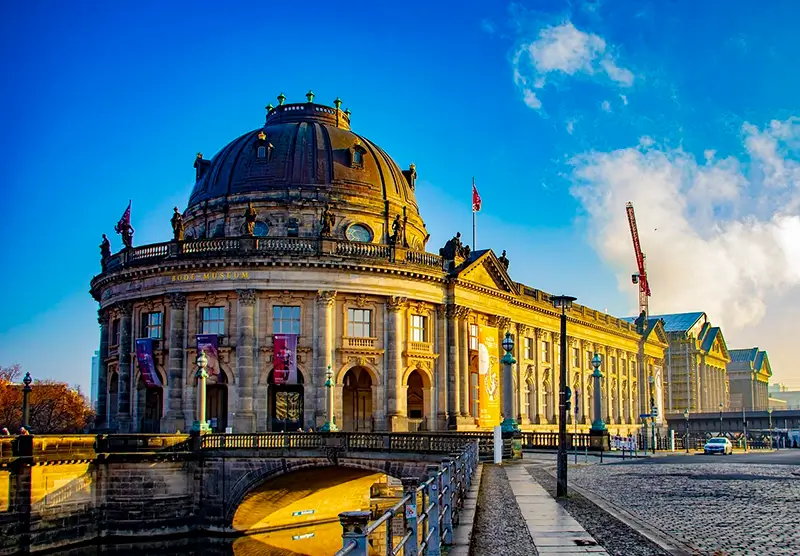
Museum Island is one of Berlin’s most famous cultural landmarks, located on the River Spree in the city’s historic centre. This extraordinary site is home to five world-class museums, each offering a window into different periods and civilisations. Its central location makes it an easy and rewarding stop for anyone exploring Berlin.
The idea for Museum Island began in the early 19th century when King Friedrich Wilhelm IV of Prussia envisioned a space dedicated to art and culture. Over the next century, the five museums were built, each showcasing unique collections ranging from ancient artefacts to 19th-century art. The island is now a UNESCO World Heritage Site, reflecting its importance as a cultural treasure.
Visitors to Museum Island can expect to see some of the most incredible collections in the world. From ancient Greek sculptures to Egyptian mummies, every corner of these museums holds something fascinating. The architecture of the buildings adds to the experience, with each museum featuring its own distinct style.
A trip to Museum Island is perfect for history and art lovers alike. With so much to discover, you can immerse yourself in stories from different eras and cultures, all in one extraordinary location.
Museums on Museum Island
- Pergamon Museum: Known for its impressive ancient structures, including the Pergamon Altar and the Ishtar Gate of Babylon.
- Altes Museum: Features classical antiquities, including Greek and Roman sculptures and artefacts from ancient civilisations.
- Neues Museum: Home to the famous bust of Nefertiti and exhibits on ancient Egyptian and prehistoric cultures.
- Bode Museum: Focuses on Byzantine art, coins, and an extensive collection of sculptures from across Europe.
- Alte Nationalgalerie: Houses 19th-century art, including works by German romantics and French impressionists.
5. Berlin Cathedral
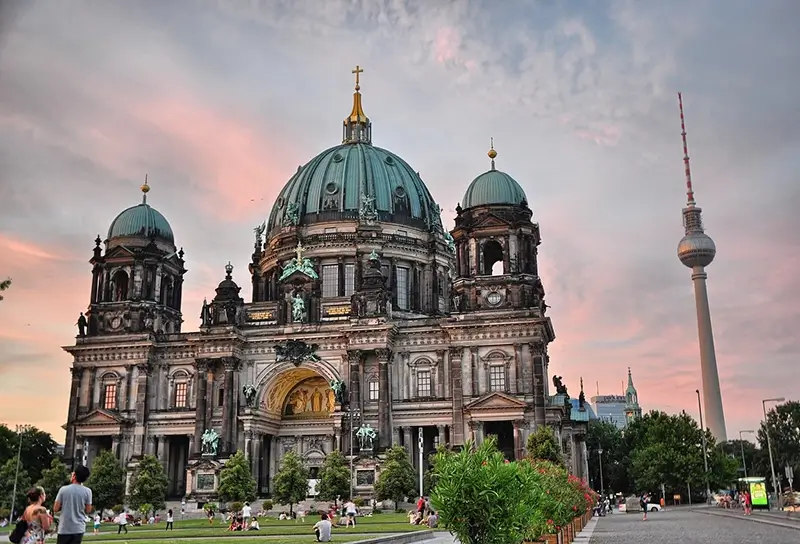
Berlin Cathedral, or Berliner Dom, is one of the most impressive landmarks in the city. Located on Museum Island, it is a stunning example of neo-Baroque architecture that dominates the skyline with its grand dome. Its central location makes it easily accessible and a highlight for visitors exploring Berlin’s cultural heart.
The cathedral was completed in 1905 under the direction of Emperor Wilhelm II and was designed to reflect the power and prestige of the Prussian monarchy. Over the years, it has served as a Protestant place of worship and a symbol of the city’s religious and architectural heritage. Despite suffering significant damage during World War II, Berlin Cathedral has been carefully restored to its former glory.
Visitors can admire the cathedral’s intricate interiors, including its stunning mosaics, ornate altar, and beautiful stained glass windows. A climb to the top of the dome offers panoramic views of Berlin, making it a popular spot for photography. The crypt below houses the tombs of members of the Hohenzollern family, adding a historical dimension to the visit.
Berlin Cathedral is not just a place of worship; it is a cultural and historical treasure. Whether you are interested in its history, architecture, or simply enjoying the serene atmosphere, it is well worth exploring.
6. Checkpoint Charlie

Checkpoint Charlie is one of the most famous tourist attractions in Berlin, located on Friedrichstrasse in the city centre. It was once a key crossing point between East and West Berlin during the Cold War, serving as a stark reminder of the division between the two sides. Today, it stands as a symbol of Berlin’s turbulent past and its eventual reunification.
Established by the Allies in 1961, Checkpoint Charlie became a crucial checkpoint for diplomats, military personnel, and foreign visitors passing between East and West Berlin. It was also the scene of dramatic escape attempts, as East Germans risked their lives to cross into the West. The checkpoint gained global attention during the standoff between American and Soviet tanks in October 1961, which brought the world to the brink of conflict.
The site now features a replica of the guardhouse and the iconic sign that reads, “You are leaving the American sector.” Nearby, the Checkpoint Charlie Museum provides detailed accounts of life during the Cold War, with exhibits about daring escapes and the construction of the Berlin Wall. It is an educational and moving experience for visitors of all ages.
Checkpoint Charlie is worth visiting for its historical significance and the insights it offers into Berlin’s divided past. It is a place that connects you to the realities of the Cold War and the resilience of those who lived through it. Whether you’re a history enthusiast or just curious about Berlin’s story, this site offers a memorable glimpse into the city’s past.
7. Charlottenburg Palace

Charlottenburg Palace is a stunning royal residence located in the Charlottenburg district of Berlin. Surrounded by beautifully landscaped gardens, the palace is the largest in the city and offers visitors a glimpse into the opulent lifestyle of Prussian royalty. Its location in western Berlin makes it a peaceful retreat from the busier parts of the city.
The palace was built at the end of the 17th century as a summer residence for Sophie Charlotte, the wife of Friedrich I, the first King of Prussia. Over the years, it was expanded and transformed into a magnificent baroque and rococo masterpiece. Despite suffering damage during World War II, the palace has been carefully restored, preserving its grandeur and historical significance.
Inside the palace, visitors can explore lavishly decorated rooms, including the stunning Great Hall and the Golden Gallery, both of which showcase intricate details and remarkable craftsmanship. The palace also houses a collection of fine art, porcelain, and historical artefacts, giving visitors an insight into Prussian history and culture.
The palace gardens are a highlight, offering a serene setting for a leisurely walk. Featuring fountains, sculptures, and the New Pavilion, the grounds are perfect for anyone looking to relax and enjoy the surroundings. Charlottenburg Palace is a must-visit for those interested in history, art, and architecture, providing a captivating journey into Berlin’s royal past.
8. Berlin TV Tower
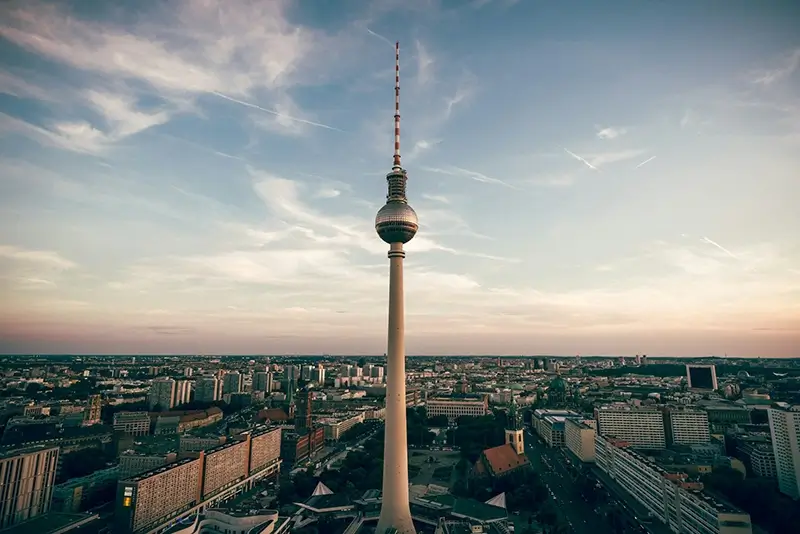
The Berlin TV Tower, or Fernsehturm, is one of the city’s most recognisable landmarks. Located in Alexanderplatz in the heart of Berlin, this iconic structure dominates the skyline and is visible from almost anywhere in the city. Standing at 368 metres, it is the tallest building in Germany and a popular destination for visitors.
Constructed between 1965 and 1969 by the East German government, the tower was intended to showcase the technological advancements and modernity of East Berlin. Its futuristic design, inspired by space exploration, reflected the era’s aspirations. Since its completion, the TV Tower has become a symbol of Berlin’s unity and progress, especially after the fall of the Berlin Wall.
A visit to the TV Tower offers breathtaking panoramic views of Berlin from its observation deck, located 203 metres above ground. On clear days, you can see landmarks such as the Brandenburg Gate, Museum Island, and even the surrounding countryside. For a truly unique experience, the revolving restaurant, located just above the observation deck, allows you to enjoy a meal while taking in the ever-changing view.
The Berlin TV Tower is more than just an architectural marvel; it provides a fantastic way to see the city from a different perspective. Its combination of history, design, and spectacular views makes it a must-visit attraction for anyone exploring Berlin.
Berlin WelcomeCard
The Berlin WelcomeCard is a valuable asset for visitors, offering unlimited travel on public transport across zones ABC, including Berlin Brandenburg Airport. It also provides discounts of up to 50% at numerous attractions, tours, and restaurants, enhancing your Berlin experience while saving money.
More Top Tourist Attractions in Berlin
9. Holocaust Memorial

The Holocaust Memorial, officially known as the Memorial to the Murdered Jews of Europe, is a deeply moving site in the heart of Berlin. Located near the Brandenburg Gate, it is one of the city’s most significant landmarks, dedicated to the memory of the six million Jewish victims of the Holocaust. Its central location makes it easily accessible for those exploring Berlin’s historical sites.
Designed by architect Peter Eisenman and completed in 2005, the memorial consists of 2,711 concrete slabs, or stelae, arranged in a grid over an expansive area. The slabs vary in height, creating an uneven and disorienting landscape. Walking through the memorial evokes a sense of reflection, solitude, and loss, as visitors are encouraged to interpret the space in their own way.
Beneath the memorial lies the underground Information Centre, which provides a more detailed exploration of the Holocaust. Through photographs, personal letters, and biographies, the centre tells the stories of individuals and families affected by the atrocities. It is a powerful and educational experience that complements the abstract nature of the memorial above.
Visiting the Holocaust Memorial is an essential part of understanding Berlin’s history and confronting the horrors of the past. It is a space for remembrance and reflection, offering a poignant reminder of the importance of tolerance and humanity. Whether you spend time exploring the Information Centre or walking through the haunting slabs, the experience is sure to leave a lasting impression.
10. Victory Column (Siegessäule)

The Victory Column, known as Siegessäule in German, is one of Berlin’s most striking landmarks. Located in the middle of Tiergarten, the city’s central park, it stands at Grosser Stern, a busy roundabout that is easily accessible from different parts of the city. Its towering golden statue is visible from afar, drawing visitors to this impressive monument.
Built between 1864 and 1873, the Victory Column was initially constructed to commemorate Prussia’s victories in three wars: against Denmark, Austria, and France. Designed by Heinrich Strack, the column originally stood near the Reichstag before being moved to its current location by the Nazis in 1938 as part of their plans for Berlin’s redevelopment. Despite its association with this era, the column remains a symbol of unity and pride.
Climbing the Victory Column is a must for visitors. After ascending 285 steps, you are rewarded with spectacular panoramic views of Berlin, including the Tiergarten, Brandenburg Gate, and the city’s skyline. The base of the column also features mosaics and plaques that depict the wars it commemorates, adding a historical touch to the experience.
The Victory Column is worth visiting for its historical significance, architectural beauty, and stunning views. It offers a unique perspective on Berlin, both literally and figuratively, making it a memorable stop for anyone exploring the city. Whether you are a history enthusiast or simply enjoy a great view, the Victory Column has something special to offer.
11. Berlin Zoo

Berlin Zoo, or Zoologischer Garten Berlin, is one of the most popular attractions in the city. Located in the western part of Berlin near the Tiergarten, it is easily accessible by public transport, with the nearby Zoologischer Garten station serving as a major hub. Spanning over 33 hectares, the zoo provides a fun and educational experience for visitors of all ages.
Established in 1844, Berlin Zoo is Germany’s oldest zoo and has a rich history. It was heavily damaged during World War II but has since been rebuilt and expanded to become one of the world’s leading zoological institutions. Today, it is home to nearly 20,000 animals from around 1,400 species, including rare and endangered ones, making it one of the most diverse collections globally.
The zoo’s highlights include its iconic giant pandas, which are a favourite among visitors, and the impressive Aquarium Berlin, which houses a wide variety of marine and freshwater creatures, reptiles, and insects. The well-designed enclosures and landscaped grounds make exploring the zoo a pleasant experience, with plenty of opportunities to learn about wildlife conservation.
A visit to Berlin Zoo is perfect for families, animal lovers, and anyone looking for a relaxing day out. With its mix of history, impressive animal exhibits, and peaceful surroundings, it offers a unique way to connect with nature while enjoying one of Berlin’s most cherished attractions.
12. Topography of Terror
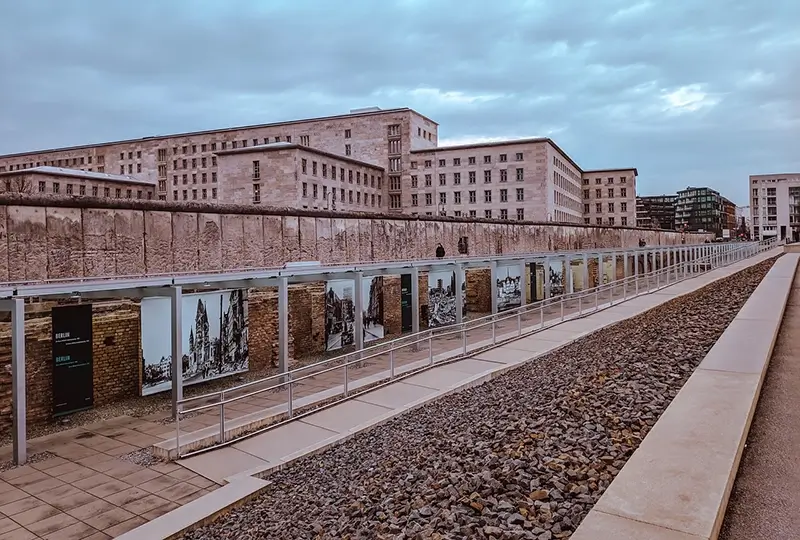
The Topography of Terror is an important historical site and museum located in the heart of Berlin on Niederkirchnerstrasse. Situated on the grounds that once housed the headquarters of the Gestapo and SS during Nazi Germany, it offers an in-depth look at one of the darkest chapters in history. Its central location, near landmarks such as Potsdamer Platz, makes it easily accessible for visitors.
This site played a significant role during the Nazi regime, serving as the command centre for terror, surveillance, and persecution. After the war, much of the area was destroyed, but in the 1980s, the remnants of the Gestapo’s basement cells were uncovered. These ruins form the basis of the museum, which was opened to the public in 2010, offering a space for education and reflection.
The outdoor and indoor exhibits detail the rise of the Nazis, the atrocities committed during their rule, and the impact on victims. Through photographs, documents, and testimonies, visitors can gain a deeper understanding of the systematic nature of the regime’s terror. The preserved sections of the Berlin Wall along the site add to the historical significance.
Visiting the Topography of Terror is a sobering but essential experience. It is a place to confront the past, learn from it, and reflect on the importance of justice and human rights. For anyone interested in understanding Berlin’s history, this site offers valuable insights into the events that shaped the 20th century.
13. Stasi Museum
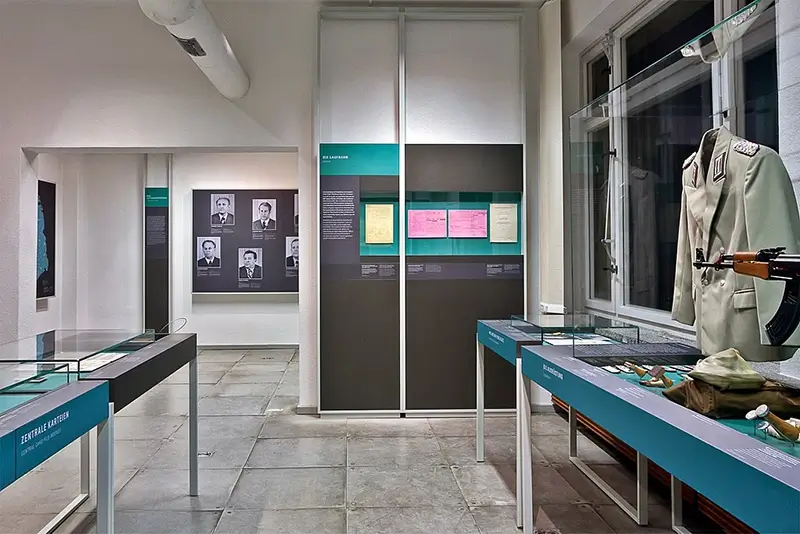
The Stasi Museum, located in Berlin’s Lichtenberg district, offers a fascinating insight into the workings of East Germany’s secret police. Housed in the former headquarters of the Ministry for State Security (Stasi), the museum is a short distance from the city centre and is easily accessible by public transport. Its location within the original Stasi offices adds authenticity to the experience.
The museum explores the history of the Stasi, a powerful organisation responsible for surveillance, propaganda, and maintaining control in the German Democratic Republic (GDR). Established in 1950, the Stasi had a vast network of informants and used advanced techniques to monitor East German citizens. After the fall of the Berlin Wall in 1989, this building became a symbol of the oppressive regime it once served.
Inside, visitors can see preserved offices, including the workspace of Erich Mielke, the former head of the Stasi. The exhibits feature original equipment used for spying, including hidden cameras and listening devices, as well as documents that highlight the extent of surveillance and control. These artefacts bring the chilling reality of life under constant observation to life.
The Stasi Museum is a compelling and educational visit, shedding light on the impact of authoritarian regimes on individual freedoms. It is a thought-provoking stop for anyone interested in Berlin’s Cold War history and the struggles for democracy and human rights.
14. Olympic Stadium

The Olympic Stadium, located in the Charlottenburg district of Berlin, is a significant landmark with a fascinating history. Easily accessible by public transport, the stadium is surrounded by the expansive Olympic Park, offering visitors a mix of sporting, architectural, and historical experiences.
Originally built for the 1936 Summer Olympics, the stadium was designed by architect Werner March and is a striking example of Nazi-era architecture. The Games were infamously used as propaganda by the regime, but they are also remembered for moments of triumph, such as Jesse Owens’ groundbreaking victories. Over the decades, the stadium has evolved into a modern facility while preserving its historical significance.
Today, the Olympic Stadium is home to Hertha BSC, Berlin’s football club, and hosts a variety of major events, including concerts and international sports tournaments. Visitors can explore the stadium on guided tours, learning about its history, design, and transformations. The venue’s panoramic views and the sense of standing in a place where history unfolded make it a memorable experience.
A visit to the Olympic Stadium is perfect for sports enthusiasts, history buffs, and architecture lovers alike. It combines a glimpse into Berlin’s past with its vibrant present, offering a unique perspective on the city’s dynamic character.
15. Clärchens Ballhaus

Clärchens Ballhaus is a historic dance hall located in Berlin’s Mitte district, offering a charming mix of nostalgia and vibrant nightlife. Situated on Auguststrasse, it has been a beloved gathering spot for Berliners and visitors alike for over a century. Its central location makes it an easy addition to an evening out in the city.
The dance hall first opened its doors in 1913 and quickly became a popular venue for music, dancing, and socialising. Over the years, it has witnessed Berlin’s changing history, surviving two World Wars and the division of the city. Its vintage interiors, including a stunning mirrored hall, evoke the glamour and romance of a bygone era, making it a unique place to experience.
Today, Clärchens Ballhaus offers a lively programme of events, from swing and tango evenings to live concerts and themed parties. The atmosphere is warm and welcoming, whether you are an experienced dancer or just want to enjoy the music and soak up the ambience. The adjoining garden is a lovely spot for a relaxed drink or meal before the dancing begins.
Visiting Clärchens Ballhaus is a chance to experience a piece of Berlin’s cultural history while enjoying its vibrant energy. It is a place where past and present come together, creating unforgettable memories for all who step through its doors.
16. Spandau Citadel

The Spandau Citadel is one of the best-preserved Renaissance fortresses in Europe, located in the Spandau district of Berlin. Situated at the meeting point of the Havel and Spree rivers, it is a peaceful escape from the city centre, easily reached by public transport. The fortress is surrounded by water, giving it a unique and picturesque setting.
Built-in the 16th century, the Spandau Citadel was designed to defend the city against invaders. Its sturdy walls, moats, and bastions reflect the military engineering of the time. Over the centuries, the citadel has served various purposes, from a stronghold to a storage site and even a refuge during World War II. Today, it stands as a testament to Berlin’s rich history and architectural heritage.
Visitors can explore the citadel’s fascinating grounds, including the Julius Tower, which offers stunning views of the surrounding area. Inside, exhibitions delve into the history of the fortress and its role in Berlin’s past. The citadel also hosts cultural events, such as concerts, theatre performances, and seasonal markets, adding a lively touch to its historical significance.
A trip to the Spandau Citadel combines history, culture, and scenic beauty. Whether you are interested in its architecture, the exhibits, or simply enjoying the tranquil surroundings, the citadel offers something for everyone. It is a rewarding experience for those looking to explore a lesser-known yet remarkable part of Berlin.
17. Berghain (Techno Club)

Berghain is an iconic venue that embodies the essence of Berlin nightlife. Located in a former power plant near Ostbahnhof station in the Friedrichshain district, it is regarded as one of the best techno clubs in the world. Known for its industrial architecture, world-class sound system, and legendary parties, Berghain is a must-visit for anyone exploring Berlin’s vibrant club culture.
The club opened in 2004 and quickly became a cornerstone of Berlin’s electronic music scene. Its name comes from the neighbourhoods it connect Kreuzberg (Berg) and Friedrichshain (Hain). Berghain’s history is deeply tied to the city’s creative and rebellious spirit that flourished after reunification, transforming forgotten spaces into hubs of art and music. Today, it remains a symbol of freedom and self-expression.
Inside, Berghain offers an unforgettable experience. The cavernous main room is dedicated to techno, featuring internationally renowned DJs and an unparalleled sound system. The Panorama Bar upstairs delivers a more melodic vibe with house music and a welcoming dance floor. The club’s minimalistic, industrial design adds to its distinctive atmosphere, creating a space that feels both raw and electrifying.
A visit to Berghain is not just about the music; it is about embracing the openness and creativity of Berlin nightlife. For techno enthusiasts and curious travellers alike, this iconic club provides a glimpse into the heart of the city’s dynamic cultural scene.
Best Tourist Attractions in Berlin of the Beaten Track
18. House of the Wannsee Conference
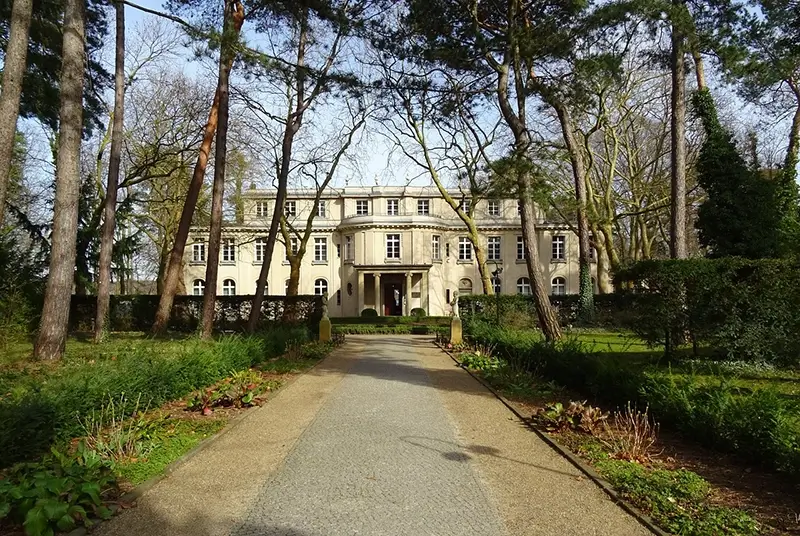
The House of the Wannsee Conference is a historic villa located on the shores of the Wannsee, a peaceful lake in southwestern Berlin. Despite its serene surroundings, the villa holds a dark and significant place in history as the site where senior Nazi officials planned the "Final Solution" in 1942. Today, it serves as a memorial and educational site dedicated to this tragic chapter of the Holocaust.
Built in 1914 as a luxurious private residence, the villa was later used by the Nazi regime for high-level meetings. On January 20, 1942, it hosted the Wannsee Conference, where officials coordinated the systematic extermination of Europe’s Jewish population. The house’s grand architecture contrasts starkly with the horrific decisions made within its walls, adding a layer of poignancy to any visit.
The site now houses a permanent exhibition that details the events of the Holocaust, the background of the Wannsee Conference, and the individuals involved. Original documents, photographs, and personal accounts help visitors understand the scope of the atrocities and the bureaucratic processes behind them. The exhibition is both informative and deeply moving.
Visiting the House of the Wannsee Conference is a sobering but vital experience. It is a place for reflection, education, and remembrance, offering important lessons about the dangers of hatred and the importance of standing against injustice. It is an essential stop for those seeking to understand Berlin’s history and the Holocaust.
19. Grunewald Forest

Grunewald Forest is the largest green space in Berlin, offering a tranquil escape from the bustling city. Located in the southwestern part of Berlin, it spans over 3,000 hectares and is easily accessible by public transport. This expansive forest is a favourite spot for locals and visitors looking to enjoy nature, whether for hiking, cycling, or simply relaxing.
The forest has a rich history, dating back centuries as a royal hunting ground for the Prussian monarchy. Its name, which translates to "Green Wood," reflects its lush and diverse landscape. Today, Grunewald is a protected area that combines natural beauty with historical landmarks, making it a fascinating place to explore.
Within the forest, visitors will find several points of interest, including the iconic Grunewald Tower, which offers stunning views of the surrounding area, and Teufelsberg, an artificial hill with a Cold War listening station. The forest is also home to several lakes, such as Schlachtensee and Krumme Lanke, which are popular for swimming and picnicking in the warmer months.
Grunewald Forest is a peaceful retreat that offers a unique blend of nature and history. Whether you are looking for outdoor activities or a quiet place to reflect, this vast green space provides a refreshing break from the urban environment. It is an ideal destination for anyone seeking a deeper connection with Berlin’s natural and historical landscape.
20. Teufelsberg

Teufelsberg, or "Devil’s Mountain," is a fascinating hill located in the Grunewald Forest, in the southwestern part of Berlin. It is an unusual destination with a unique blend of history, art, and panoramic views. Easily accessible by public transport or bike, it offers a different perspective on the city.
The hill is not a natural formation but an artificial one, built from rubble left over after World War II. Beneath its surface lies an unfinished Nazi military-technical college, which was buried under millions of tonnes of debris. During the Cold War, Teufelsberg gained strategic importance as the site of an American listening station used for spying on the Eastern Bloc.
Today, the remains of the listening station, with its distinctive radar domes, are a canvas for street artists from around the world. The site has become an open-air gallery, covered in vibrant murals and graffiti. Visitors can explore the ruins, soak in the creative energy, and enjoy breathtaking views of Berlin and its surroundings from the top of the hill.
Teufelsberg is a unique destination that combines history, art, and nature. Whether you are drawn to its Cold War past, the artistic atmosphere, or simply the stunning views, a visit to Teufelsberg is an unforgettable experience that shows a different side of Berlin.
21. Spreepark

Spreepark is an abandoned amusement park located in Berlin’s Treptower Park district, offering visitors a glimpse into a surreal and nostalgic part of the city’s history. Situated alongside the River Spree, it is surrounded by greenery, making it an intriguing destination for those who enjoy exploring the unexpected.
The park opened in 1969 as the Kulturpark Plänterwald, the only permanent amusement park in East Germany. It was a popular attraction, featuring classic rides such as a Ferris wheel and roller coasters. After German reunification, the park was privatised and renamed Spreepark, but financial difficulties led to its closure in 2002. Since then, the site has remained abandoned, with its overgrown rides and structures creating a haunting yet fascinating atmosphere.
Guided tours of Spreepark allow visitors to explore its eerie remains, including the rusting Ferris wheel and crumbling roller coasters. The tours provide insight into the park’s history, from its days as a vibrant family destination to its current state as a forgotten relic of Berlin’s past. The combination of decaying attractions and nature reclaiming the space creates a unique and thought-provoking experience.
Visiting Spreepark is like stepping into a time capsule that tells a story of change and resilience. It is a must-see for those interested in urban exploration, history, or simply seeing a different side of Berlin. The site’s blend of mystery and nostalgia makes it a truly memorable destination.
22. Pfaueninsel (Peacock Island)

Pfaueninsel, or Peacock Island, is a tranquil and picturesque island located on the River Havel in southwestern Berlin. Accessible by a short ferry ride, this hidden gem offers a peaceful retreat from the hustle and bustle of the city. Its name comes from the peacocks that roam freely on the island, adding to its unique charm.
The island’s history dates back to the late 18th century when King Friedrich Wilhelm II of Prussia commissioned a summer residence there. The centrepiece of the island is a romantic white castle, designed to resemble a ruin and set amid beautifully landscaped gardens. Pfaueninsel became a favourite getaway for Prussian royalty, hosting gatherings and private retreats.
Today, the island is a UNESCO World Heritage Site, recognised for its cultural and historical significance. Visitors can explore its winding paths, lush greenery, and hidden corners. The island’s natural beauty is complemented by its historical features, such as the rose garden, the historic dairy farm, and the carefully maintained meadows and forests.
Pfaueninsel is ideal for a day trip, offering a perfect mix of history and nature. Whether you’re enjoying a leisurely stroll, admiring the peacocks, or soaking in the serene atmosphere, the island provides a truly relaxing escape from city life.
Book Your Trip to Berlin
To book a hostel in Berlin, always use Hostelworld to get the best possible price.
- The Circus Hostel - The overall best hostel in Berlin
- Kiez Hostel Berlin - Best Hostel in Berlin for Solo Travellers
- A&O Berlin Mitte - The best cheap hostel in Berlin
- The Circus Hostel - Best Hostel in Berlin for Partygoers
- MEININGER Berlin Alexanderplatz - Best Design Hostel in Berlin
Final Thoughts on the Tourist Attractions in Berlin
The best tourist attractions in Berlin showcase the city’s rich history, vibrant culture, and dynamic energy. From iconic landmarks like the Brandenburg Gate and the Berlin Wall to unique experiences in neighbourhoods full of creativity, Berlin offers something for everyone. Exploring these attractions gives you a deeper understanding of the city’s past and present.
Berlin is a place where history comes to life. Walking through its streets, you can see the impact of significant events, from the rise of Prussia to the fall of the Berlin Wall. The city’s museums and memorials, such as the Holocaust Memorial and the Topography of Terror, provide opportunities for reflection and learning, making Berlin an important cultural destination.
The city’s modern side is equally captivating. Its thriving arts scene, buzzing nightlife, and vibrant markets create a lively atmosphere that keeps visitors coming back. Each neighbourhood, from the historic charm of Mitte to the edgy vibes of Kreuzberg, adds its own flavour to the experience.
Berlin is more than just a city; it is an unforgettable journey through history, culture, and creativity. Visiting the best tourist attractions in Berlin ensures you leave with memories and a true appreciation for this remarkable destination.
More on Berlin and Germany
